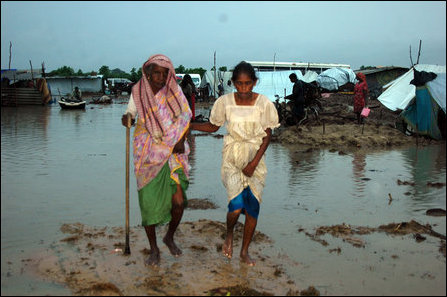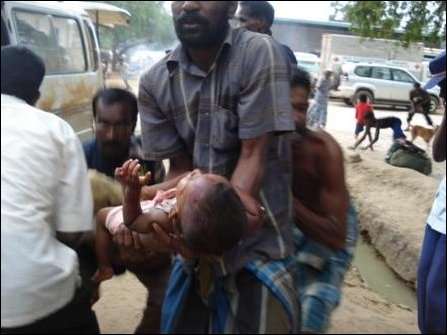Ilankai Tamil Sangam30th Year on the Web Association of Tamils of Sri Lanka in the USA |
||||||
 Home Home Archives Archives |
Crushing VictoryThe Guardian editorial, UK, April 11, 2009
It started in the year Apple produced its first personal computer, a Soviet fighter shot down a Korean airliner, Neil Kinnock was elected Labour leader and 38 IRA prisoners escaped from the Maze. The Soviet Union is long gone; one of the escape leaders is now a junior minister in the Northern Ireland government; but the conflict in Sri Lanka grinds on to the bitter end. Nothing like the Good Friday agreement here. It is ending in a murderous round of shelling. About 100,000 people are trapped on a coastal strip, an area of eight square miles. The Sri Lankan government has declared it a no-fire zone, and bridles at comparisons with Gaza. But as Human Rights Watch said yesterday, that coastal strip has become one of the most dangerous places in the world.
On Tuesday a doctor in a hospital in nearby Putumattalan received 133 wounded and 20 dead bodies, all victims of shelling in Pokkanai, within the no-fire zone. On Wednesday the figures were 296 wounded and 46 bodies. On Thursday the hospital received 300 wounded and 62 bodies. The victims of the first shelling were hundreds of civilians queueing for milk powder, the first available to them for three months. The Sri Lankan government denies everything, even though doctors have collected shrapnel from 120mm rounds that they used. They deny both the number trapped in the enclave (they claim it is 40,000) and the fact that their troops are shelling it. The suffering of the civilians trapped on the beach, they say, is solely down to the Liberation Tigers of Tamil Eelam (LTTE).
No shortage of charges can be can be laid at the door of the defeated army of the Tamil Tigers. They have shot civilians attempting to flee; they have used them as human shields; they have used children to dig bunkers, to collect weapons from killed cadres and Sri Lankan soldiers, and to fight. In February the UN Children's Fund, Unicef, said that children as young as 14 were being forcibly recruited. But none of this absolves the Sri Lankan government of its responsibility to end the grotesque loss of innocent life. Sri Lanka's defence secretary, Gotabhaya Rajapaksa, said in February that all persons subject to attack by his armed forces were legitimate LTTE targets. He is only being true to his word. But his statement goes to the heart of a second major concern. The Sri Lankan army is not releasing those who manage to flee the fighting. They are being put into camps, where they are not allowed to communicate with the outside world. At Menik Farm, one of the largest, a second line of barbed wire was installed so that outsiders can not approach. Here, according to one aid worker, the camp is being prepared to receive 400,000 refugees, a figure which appears to indicate that the number of refugees is much bigger than is suggested by the official claims that 60,000 have left the Tamils' coastal strip and 40,000 are left. Aid agencies are allowed to visit the camps near Vavuniya, but can not monitor what happens in them, register who is inside them or how many disappear from them. As it is, 25 people a month are disappearing from Vavuniya in what have become known as the "white van abductions". After a conflict this long, any army would have a problem sorting out guerrillas from civilians or clearing the thousands of landmines that have been laid. The government calls these camps "welfare centres", but no amount sophistry can disguise the fact that these are internment camps, whose inmates are subject to indefinite confinement. There are UN principles regarding the treatment of internally displaced people. They have the right to essential medicines, food, shelter. They have the right to communicate with their families and to return to their villages. The Sri Lankan government should be held to account by the international community. In victory, no less than in defeat, civilians are made to suffer. |
|||||
|
||||||

